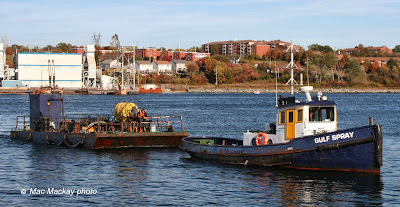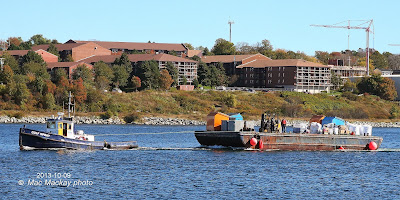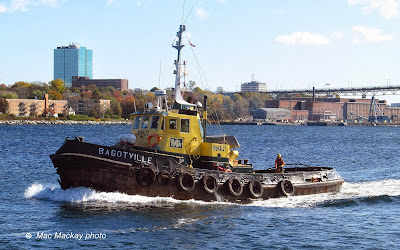Groupe Océan is making tug news again with acquisitions and sales.
1. Pointe aux Basques and Pointe Sept-Iles reported sold.
I have received reports from several sources that Groupe Océan has purchased
Pointe aux Basques and
Pointe Sept-Iles from Svitzer Canada. As previously reported, the two tugs were idled when Svitzer's contract with the Iron Ore Company of Canada was not renewed. Svitzer, and its three predecessors, Ectug, MIL Tug and Foundation Maritime, had provided tugs in Sept-Iles since 1956 (and possibly earlier), and these twin screw icebreaking tugs were built to work there. The contract ended August 1, 2013.
Groupe Océan became well established in Sept-Iles the past few years, with their tugs supporting construction, dredging and ship-lightering in the bay. They now provide tug service at both Pointe-Noire and at Sept-Iles. They also chartered
Océan Arctique and
Océan Stevns last summer with an option to buy, and have stationed them in Sept-Iles.
2. Point Valiant in refit, Lunenburg.
Pointe Sept-Iles found work in Belledune, NB and is presently filling in
at Point Tupper while
Point Valiant is in refit at Lunenburg.
Pointe aux Basques arrived in Halifax October 10 and has been idle ever since.
Océan had previously reported that they would be assigning two tugs to Bull Arm next year, so these may be the tugs they will use.
Meanwhile Groupe Océan has listed the tug/barge combination
Mega and
Motti with Marcon International ship brokers. I hear that Océan bought the combo for a contract, which was subsequently cancelled. The transatlantic delivery of the pair last winter and spring, was a bit of a marathon, with extended stops in the Las Palmas and Hamilton, Bermuda.
Full particulars on the pair may be found on Marcon International's web site:
http://www.marcon.com/marcon2s.cfm?SectionGroupsID=20&SectionListsID=20&PageID=24&Action=Detail&File=HB42678Also on the For Sale list are
Océan Delta and
Océan Foxtrot. These two are among the senior citizens in the Océan fleet, and with newer tugs available and on the way, they will have to go.
Océan Delta was Océan's largest tug, Built in Norway 1973 for the International Towing Contractors as
Sistella it was renamed
Sandy Cape in 1978, and in 1980 came to Canada for Québec Tugs [Quetug], then part of Davie Shipbuilding, which was owned by Canada Steamship Lines. Renamed
Captain Ioannis S. (for Capt "John" Styliadis) it worked on the St.Lawrence, on the east coast, towing icebergs and in the arctic and farther afield. When the present Groupe Océan acquired the Quetug fleet they retained the name until 1999 when it became
Océan Delta.
3. In Halifax in June 1997, the tug wearing its Quetug funnel marking.
4. In August 1996 it teamed up with fleetmate Océan Foxtrot to assist in the tow the oil rig Spirit of Columbusfrom Halifax to Quebec City for rebuilding.Foxtrot was carrying the name and wearing the new colours of Groupe Océan
Océan Delta made the headlines a year ago during the ill-fated tow of HMCS
Athabaskan from St.Catharines, ON toward Halifax. As lead tug,
Delta was plagued by breakdowns, (and I hear a scratch crew). They had to abort the tow in Sydney, NS, after the towline parted and the warship was holed when it made contact with the tug. Atlantic Towing Ltd completed the tow.
Groupe Océan spent a lot of money on the tug over the years, including a re-engining, when its original 5,600 bhp N+H was replaced with a 6,464 bhp MaK in 2000. However large single screw tugs* are becoming dinosaurs, and with a spring delivery of Océan's new
Océan Tundra the
Delta will be replaced with a much more capable ship.
[* Marcon categorizes the tug as twin screw in its index, but the actual listing shows it correctly as single screw.]
5. Trading a Halifax grain elevator for Quebec City grain elevator as a backdrop, Océan Delta rests in its home port. It was just about to enter a summer refit. Soon after this photo was taken the Océan funnel mark changed again to a broader black cap and no logo.
For Marcon's listing of
Océan Dleta see:
http://www.marcon.com/marcon2s.cfm?SectionGroupsID=20&SectionListsID=20&PageID=8&Action=Detail&File=TG56000
Océan Foxtrot is an untypical tug for Groupe Océan. It was built as an anchor handling supply tug, with lots of pulling power for its size. Originally Polar Shore it came out of the Cochrane Yard in Selby, England in 1971 for Offshore Marine. With 72 tonnes bollard pull from a pair of Ruston-Paxmans totaling 5,280 bhp, it was considered a powerful vessel in its day. As its name implied it was built for work in northern waters to Lloyds Ice Class 1.
In 1988 Canadian Marine Drilling bought the tug, renamed it Canmar Supplier VII and put it to work in the Beaufort Sea. Quetug bought it in 1995, giving it the name Océan Foxtrot and initially put it to work as pusher tug, with a special bow fitting. That was removed in Halifax in March 1999.
6. Océan Foxtrot with pushing fender. The former Coast Guard landing craft Nanook, then owned by Océan is alongside.
7. On a bitingly cold day in Halifax, Ocean Foxtrot carries a bit of frozen spray on its return from a trip to Come-by-Chance, NL in 2003.
Meanwhile it worked on numerous unusual projects, such as dive support for the Irving Whale salvage in 1995, the Swiss Air crash recovery in 1998, several cable repair jobs, and salvage tows.It has also worked offshore and in the north. I am sure Océan will miss its versatility if it sells.
6. Océan Foxtrot leaving Halifax for a cable repair project. It has been fitted with a slide over its stern roller, and carries a containerized fibrepoptic splicing shop on deck.
Being "For Sale" doesn't mean "Sold" so we will have to wait and see what happens to these two tugs. Marcon is also listing McKeil's Tony MacKay - more on it another time.
.





























































